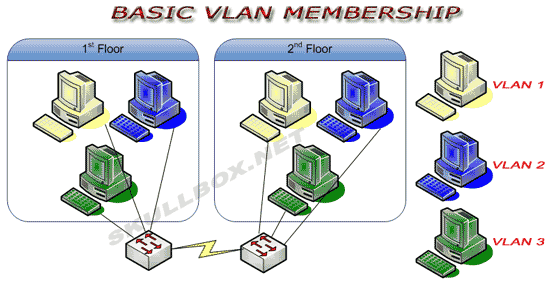
|

|

|

|

|

|

|

|

|

|

|

|

|

|

|

|

|

|

|

|

|

|

|

|

|

|

|

|

|

|
 |
|
|
|
|
Mailing List
|
|
By Joining the mailing list you will be notified of site updates.
|
|
Show Your Support For
This Site By Donating:
|
|
|
|
|


|
|
|
|
|
|
 This article describes the concept of the VLAN. VLANs are commonly used to speed up networks and reduce congestion. You may also want to see a video demonstration of VLAN configuration using Cisco switches.
This article describes the concept of the VLAN. VLANs are commonly used to speed up networks and reduce congestion. You may also want to see a video demonstration of VLAN configuration using Cisco switches.
Overview
Virtual LAN; a logical, not physical, group of devices, defined by software. VLANs allow network administrators to resegment their networks without physically rearranging the devices or network connections¹. A VLAN (Virtual LAN) is a network composed of logical broadcast domains. Configuration VLANs allows network traffic to be seperated logically. Network devices on VLAN1 will not be able to communicate (ping) devices on VLAN2. It is possible to have devices on VLAN1 of a switch communication with VLAN1 on another switch through a method called VLAN trunking. See the image below:

This diagram gives you the basic idea of VLAN membership. You can see how the floors of the building are seperate and that each department is represted by a different color. The switches lie below and the trunk link is represented by the lightning bolt. Trunk links may also be referred to as .1q or "dot one Q." This refers to the IEEE standard of 802.1q which defines the method of vlan trunking.
Types of Membership
There are several different types of memberships associated with VLANs:
- Static VLANs
- Dynamic VLANs
Static VLANs are specified by switch port. For example, a 12 port fast ethernet switch is split for the creation of 2 VLANs. The first 6 ports are associated with VLAN1 and the last 6 ports are associated with VLAN2. If a machine is moved from port 3 to port 11, it will effectively change VLANs.
Dynamic VLANs are specified by MAC address. Assuming the same scenario, a system administrator will enter MAC addresses for all machines connecting to the switch. These addresses will be stored in a memory chip inside the switch that forms a database of local MAC addresses. Each MAC address can then be associated with a certain VLAN. This way, if a machine is moved, it will retain the original VLAN membership reguardless of it's port number.
VLAN Tagging
Moving VLAN data over multiple switches uses a method called VLAN tagging. The act of VLAN tagging simply adds extra information in the packet header of ethernet frames so routers know how to pass along the data. See the following for information on creating VLAN membership and trunking on HP Provcurve Switches.
VLAN Enabled Switches
Not all switches support VLANs. Most "managed" switches including Dell, Netgear, HP, and others all support vlans. Remember that because VLAN tagging is a universal standard, different brands of switches can accomplish the same thing. Data centers are large enivronments should standardize on a specific platform. Cisco has created proprietary protocols to manage VLANs called VLAN Trunking Protocol or VTP which enables Cisco switches to advertise VLAN routes to other VTP enabled switches. This also allows a system administrator to manage all VLANs from a central point and order all switches to update the VLAN information along the entire network. Most orgainizations using VLANs have figured out it is worth shelling out the extra cash to go with Cisco equipment and get the extra features and functionality.
Contact Us
NOTE: this form DOES NOT e-mail this article, it sends feedback to the author.
|
¹ link to original source is now depreciated.
|
|
|
|
|
